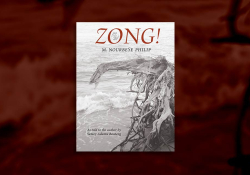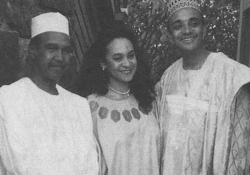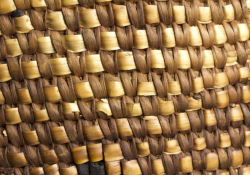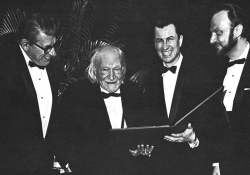Mario Vargas Llosa: Word and Fire
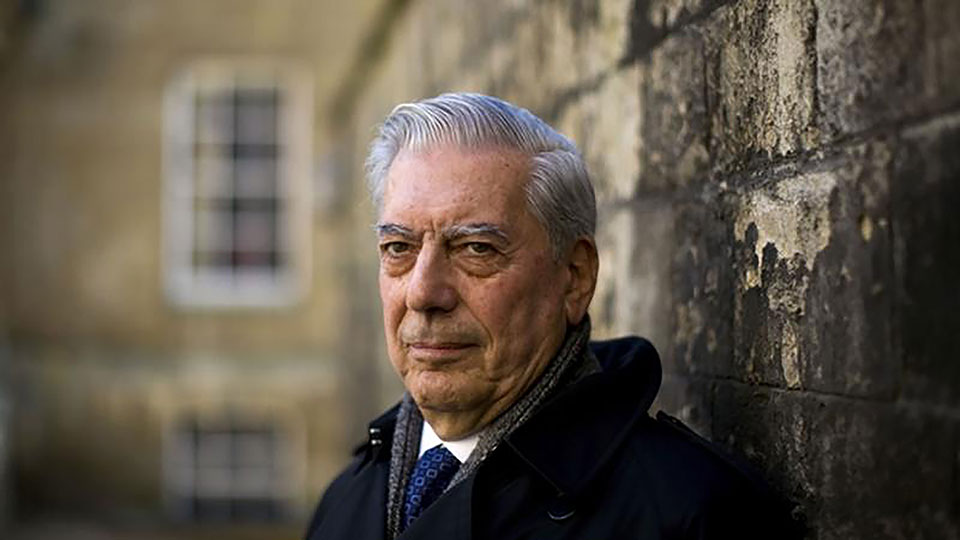
To celebrate the eightieth birthday of 2004 Neustadt Prize nominee and 1977 Puterbaugh Fellow Mario Vargas Llosa, Peruvian journalist Raúl Tola presents the following overview of the Nobel laureate’s career.
On that October morning, while he was waiting for the news to be announced, Mario Vargas Llosa thought to himself. From his apartment on the forty-sixth floor, he could see the Hudson River and a part of Central Park, now bathed in autumn red. Like every year, he spent some time in New York while teaching at Princeton University. He had thought about going over The Kingdom of This World by the Cuban writer Alejo Carpentier and using some examples for his class, taking his customary walk, and preparing his biweekly column, Piedra de toque (Touchstone), but the news turned everything upside-down. He had just received a call from Stockholm to inform him that the Swedish Academy had decided to award him the 2010 Nobel Prize in Literature, and his imagination became swept up in images, faces, places, and memories.
Although it seemed like he was admiring the Manhattan skyline, at that moment he was somewhere else: walking the cobblestone streets with white stone houses and the volcanic landscape of the city of Arequipa, where he was born in 1936. He had a nomadic infancy, with frequent moves after his first birthday when his parents divorced. Soon he moved to Cochabamba, Bolivia, where his grandfather Pedro was hired to run a cotton ranch.
Vargas Llosa would learn to read in Brother Justiniano’s class in La Salle College of Cochabamba. Soon he was burying himself in books by Jules Verne, Alexandre Dumas, and Victor Hugo.
The Llosa family lived in a house on Ladislao Cabrera Street, and there, unintentionally, the literary path of the future writer began. As he explained in his acceptance speech for the Nobel, Vargas Llosa would learn to read in Brother Justiniano’s class in La Salle College of Cochabamba. Soon he was burying himself in books by Jules Verne, Alexandre Dumas, and Victor Hugo. He didn’t know it, but the best fiction would occur in real life. His family had him believe his father was dead so as to avoid telling Mario that his father had separated from his mother.
The family returned to Peru in 1945 when his grandfather was named prefect in Piura. Soon he had made friends who would run around under the tamarind trees in the main plaza or crawled over sand dunes to spy on an old house, which was painted green and served as a whorehouse. Those happy times spent in that parched city in northern Peru were short-lived and ended abruptly when he learned his father was alive and went to meet him. He and his mother had secretly reconciled with each other, and the three of them went to live together.
They moved to Lima and found a place in Magdalena del Mar, a neighborhood of humid streets and old mansions bordering the Pacific Ocean. From there they went to La Perla, in the port of Callao. Life in that house was asphyxiating and, oftentimes, violent. His father was authoritarian and hostile and terrified his son. In order to straighten him out, he was sent to the Leoncio Prado Military School, where for two years he was subjected to rigid military discipline. But instead of wilting, his precocious vocation as a writer took root. It was in those barracks where Vargas Llosa read more than ever, and soon he was asked to write love letters for the other cadets in exchange for cigarettes. Life in the barracks ended on the weekends when he would hook up with his friends in the Diego Ferré neighborhood in Miraflores to play soccer, swim in the ocean, or go strolling in Salazar Park.
At the end of his second year at Leoncio Prado, he returned to an uncle’s house in Piura, where he found happiness being away from his father. He finished high school there, wrote for La Industria newspaper, and had his first literary success with the play La huida del inca (Escape of the Inca).
Vargas Llosa returned to Lima to study law and literature at San Marcos University. It was the period of the Odría military government, and together with a few classmates they joined Cahuide, a clandestine cell under the rubric of the Communist Party. He later became affiliated with Christian Democracy and Castroism before finally embracing liberalism, which he now strongly defends. At the tender age of nineteen, he married Julia Urquidi, the sister of an aunt-in-law who was ten years older. To maintain the new household, he held up to seven jobs, without abandoning the university.
About that time Vargas Llosa had published his first short stories in local newspapers; but his literary future would really take shape in late 1957, when his short story “El Desafío” (The Challenge) won first place in a competition sponsored by the Revue Française. He traveled to Paris for a month and, upon returning to Peru, graduated from the university and spent fifteen days in the Amazon jungle. Shortly thereafter, he received a scholarship to study in Spain. At twenty-two years of age and while he was studying law at the Complutense University of Madrid, he decided what he wanted to be: a writer. Soon, he won the Leopoldo Alas prize in Spain for an anthology of short stories that would be published as Los jefes (1979; The leaders).
Always grounded in realism, Vargas Llosa himself has theorized about the relationship between life and writing novels, affirming that writing is a reworking of one’s own experiences. This process would be like a strip tease in reverse.
These clues help understand the autobiographical origins of Vargas Llosa’s fiction. Always grounded in realism, he himself has theorized about the relationship between life and writing novels, affirming that writing is a reworking of one’s own experiences. This process would be like a strip tease in reverse: “Writing novels would be the equivalent of what a professional does before an audience by removing one’s clothes and exposing his body. The novelist would perform this act in reverse. From that initial nudity, which is the point of departure of a spectacle, the process of the novel would clothe itself by concealing dense and multicolored garments.”
It has become quite clear how the years Vargas Llosa spent at Leoncio Prado led to creating the basis for La ciudad y los perros (1962; Eng. The Time of the Hero, 1966), in which he describes an honor code based on bullying and lying to survive an environment addicted to corruption, racism, and machismo, and where cunning cadets outnumbered the honest ones. Published when he was only twenty-seven years old, that first novel was dazzling for its caliber, ambition, and formal challenges, practically unknown in Latin American literature. Shouldering inequalities, hatreds, and different personalities, the cadets at Leoncio Prado were a precise X-ray of a society as complex as the Peruvian one. Readings and literary criticism have continued ever since The Time of the Hero was published, which marked the beginning of the Latin American “Boom” period and included Gabriel García Márquez from Colombia, Julio Cortázar from Argentina, Guillermo Cabrera Infante from Cuba, and Carlos Fuentes from Mexico.
Vargas Llosa’s biography reappeared barely camouflaged in his second novel. Beginning with the title, La casa verde (1965; Eng. The Green House, 1968) gives honor to a brothel with reed walls and a straw roof that the novelist secretly observed when he was a young boy in Piura. This first story is enriched by a second that takes place in a remote region seemingly unrelated: a religious mission in Santa María de Nieva, embedded in the heart of the Peruvian Amazon. Vargas Llosa owed the portent of that literary engineering to his readings of the works by William Faulkner, in which he discovered “the sorcery of the fictional format, the symphony of points of view, ambiguities, the nuances, tonalities, and perspectives with which an astute construction and a careful style can endow a story.”
His time spent at San Marcos University in Lima and his running around as a furtive communist in the Cahuide cell during the Odría dictatorship provided the background for Conversación en La Catedral (1969; Eng. Conversation in the Cathedral, 1974), perhaps his most celebrated novel (the author himself has said if he would have to save one of his novels from a fire, it would be this one). In this novel he takes to the limit such techniques as las cajas chinas (Chinese boxes, a structure in which a story is derived from another story), el dato escondido (the so-called hidden fact), los vasos comunicantes (two or more episodes in different places and time are strengthened through association), and los diálogos telescópicos (telescopic dialogues, defined by the critic José Miguel Oviedo as “the montage of two dialogues, one in the present and another evoked and updated in the first one, which occur in two distinct moments in time and space”).
Then Pantaleón y las Visitadoras (1973; Eng. Captain Pantoja and the Special Service, 1978) came along, in which Vargas Llosa returns to the environment of the Amazon jungle to tell the story of the eagerness and misadventures of the meticulous captain of the Peruvian army, Pantaleón Pantoja, who was assigned the difficult task of organizing a prostitute service in order to maintain the morale of the troops. Influenced by the ideas of Sartre and notions of the committed intellectual, he first considered writing a serious work, only to allow later for humor to permeate each page of his writing.
This cycle of ambitious, totalizing, and experimental novels continued with La tía Julia y el escribidor (1977; Eng. Aunt Julia and the Scriptwriter, 1982)—perhaps his most autobiographical work—along with The Time of the Hero, in which he re-creates the adventure of marrying his second cousin as well as the time he spent as a writer for a radio station in downtown Lima. This cycle ends with La guerra del fin del mundo (1981; Eng. The War of the End of the World, 1985), in which he finally abandons personal stories for a foreign story, as told by Euclides da Cunha in Os sertões (1902; Eng. Rebellion in the Backlands, 1944), that is to say, the anti-republican revolution of the fanatical followers of Antonio Conselheiro, preacher and founder of Canudos in Brazil.
Then came works of lesser importance—Historia de Mayta (1984; Eng. The Real Life of Alejandro Mayta, 1986), ¿Quien mató a Palomino Molero? (1986; Eng. Who Killed Palomino Molero?, 1987), El hablador (1987; Eng. The Storyteller, 1989), Lituma en los Andes (1993; Eng. Death in the Andes 1996), including two erotic novels, Elogio de la madrastra (1988; Eng. In Praise of the Stepmother, 1990) and Los cuadernos de don Rigoberto (1997; Eng. The Notebooks of Don Rigoberto, 1998)—after which Vargas Llosa’s interests took him in another direction. Until then, he had always participated in public debates through articles, interviews, and pronouncements. Particularly notable was “El francotirador tranquilo” (The tranquil sniper), a response to Persona non grata (1973; Eng. Persona non grata, 1977), by Jorge Edwards, in which Vargas Llosa broke with the Fidel Castro regime; but it was his leadership of protests in 1987 against the intentions of then-President Alan García to nationalize Peru’s financial system that made him decide to become involved in politics as a presidential candidate in the 1990 elections. Although he started out as the most popular candidate, Vargas Llosa ended up losing to Alberto Fujimori.
The intense experiences gained from that campaign and his infancy and youth were translated into what became his memoir, El pez en el agua (1993; Eng. A Fish in the Water, 1994). An awaited return to the literary world produced La fiesta del chivo (2000; Eng. The Feast of the Goat, 2001), in which he narrated the ascent, heyday, and assassination of President Rafael Leonidas Trujillo, who tyrannized the Dominican Republic from 1930 to 1961 with a mixture of sadism, megalomania, torture and assassination of the opposition, and restricting citizens’ right to a minimum. Later, in 2003, he published El paraíso en la otra esquina (Eng. The Way to Paradise, 2003), which counterbalanced the lives of the writer and political activist Flora Tristán and her grandson, the painter Paul Gauguin, in addition to Travesuras de la niña mala (2006; Eng. The Bad Girl, 2007). Just when he flew to New York to teach a course at Princeton University, he was about to publish El sueño del celta (2010; Eng. The Dream of the Celt, 2012), a fictional biography about Roger Casement, a diplomat and Irish revolutionary who denounced the abuses of rubber barons in the Congo and Putumayo.
Returning to that October morning on the forty-sixth floor in Manhattan, it had just turned six o’clock. After reviewing his life and letting his children know what was about to happen, Vargas Llosa and his wife Patricia watched the television only to see Peter Englund of the Swedish Academy announce the following: “The 2010 Nobel Prize for Literature has been awarded to the Peruvian writer Mario Vargas Llosa for his cartography of structures of power and his trenchant images of the individual’s resistance, revolt, and defeat.”
This story should have ended here, with Vargas Llosa happy about the news in his apartment, which began to fill up with journalists who asked him in multiple languages about his first impressions; or three months later, when he was in the Great Hall of the Swedish Academy reading his acceptance speech for the Nobel Prize: “Elogio de la lectura y la ficción” (In Praise of Reading and Fiction); or when King Carl XVI Gustaf gave him the award in the Stockholm Concert Hall on December 10, 2010.
But that is not what happened, because after surveying a landscape of high rises, where the Hudson River winds like a snake with a piece of Central Park in view, and to review over a period of fourteen minutes the most stellar moments of his life, Vargas Llosa made the decision not to let the Nobel Prize become a literary death certificate, as has happened to other writers, or something akin to becoming a statue. In addition to maintaining a position of debate through public appearances and opinion columns, he has lately published two novels, El héroe discreto (2013; Eng. The Discreet Hero, 2015) and Cinco esquinas (2016; Five corners); a book of essays (La civilización del espectáculo, 2012; Eng. Notes on the Death of Culture, 2015); and even dared to climb the stage of the Spanish Theater of Madrid to interpret the Duke of Ugolino in Los cuentos de la peste (2015; Stories of the plague), his adaptation of Boccaccio’s Decameron. The celebration of his eightieth birthday coincided with the inclusion of his works in La Pléiade, a canonical collection of world literature published by the French publishing house Gallimard.
This ironclad consistency in his vocation—which has not diminished the honors, the flattery, the setbacks, or the passage of time—can only be understood through the eighty years of Vargas Llosa’s life in which he understood literature “as it should be: like a daily and furious sacrifice.” When it comes time to take stock, along with his novels (among which there are at least four masterpieces), his legacy will consist of that absolute commitment to writing: a fire born out of rebellion and inconformity that permits “the creation of a parallel life to seek refuge from adversity and makes the unusual seem normal and the normal unusual, dissipates chaos, embellishes ugliness, eternalizes the moment, and turns death into a passing spectacle.”
Lima, Peru
Translation from the Spanish
By Dick Gerdes
